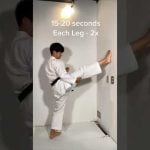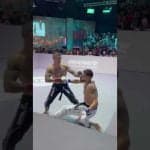Flexibility plays a crucial role in the practice of karate. It allows martial artists to perform dynamic kicks, strikes, and evasive maneuvers with ease and precision. Whether you’re a beginner or an experienced karateka, improving flexibility should be a key focus in your training regimen. In this article, we will explore the essential tips and techniques for enhancing flexibility specifically for karate practitioners.
1. Dynamic Stretching
Dynamic stretching is a highly effective method to improve flexibility for karate. This technique involves moving parts of your body through a full range of motion, actively engaging the muscles and increasing blood flow. Dynamic stretches are performed in a controlled and deliberate manner, mimicking the movements used in karate techniques. This type of stretching helps to warm up the muscles, increase their elasticity, and improve overall flexibility.
Key dynamic stretches for karate:
- Leg swings: Stand next to a wall and swing one leg forward and backward, gradually increasing the range of motion. Repeat with the other leg.
- Arm circles: Extend your arms to the sides and make circles in a forward and backward motion. Start with small circles and gradually increase the size.
- Trunk twists: Stand with your feet shoulder-width apart and twist your upper body from side to side, engaging your core muscles.
2. Static Stretching
Static stretching involves holding a stretch position for a prolonged period of time, typically around 30 seconds. This technique helps to elongate the muscles and improve flexibility over time. It is recommended to perform static stretches after a workout or training session, as it helps to cool down the muscles and prevent injury.
Key static stretches for karate:
- Hamstring stretch: Sit on the floor with one leg extended and the other bent. Reach forward, aiming to touch your toes while keeping your back straight.
- Quad stretch: Stand upright and grab your ankle, pulling it towards your glutes while keeping your knees close together.
- Shoulder stretch: Extend one arm across your chest, using the other arm to gently pull it closer to your body. Switch sides and repeat.
3. Proprioceptive Neuromuscular Facilitation (PNF)
PNF stretching is a more advanced technique that involves a combination of contraction and relaxation of targeted muscles. It is highly effective in improving flexibility by increasing the muscle’s ability to stretch further. PNF stretching should be performed with a partner to assist in the contractions and relaxations.
Key PNF stretches for karate:
- Leg extension: Sit on the floor with one leg extended. Have your partner push gently against your leg while you resist the movement. After a few seconds, relax and allow your partner to push your leg further into the stretch. Repeat with the other leg.
- Shoulder rotation: Stand upright with your arms extended to the sides. Have your partner gently push your arms backward, while you resist the movement. Relax and allow your partner to push your arms further into the stretch. Repeat with the arms forward.














